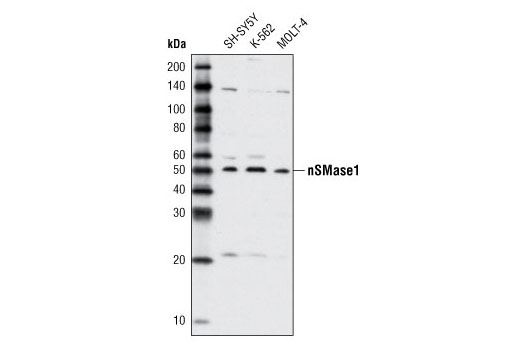WB
H Mk
Endogenous
50
Rabbit
#O60906
6610
Product Information
Product Usage Information
| Application | Dilution |
|---|---|
| Western Blotting | 1:1000 |
Storage
Specificity / Sensitivity
Species Reactivity:
Human, Monkey
Source / Purification
Polyclonal antibodies are produced by immunizing animals with a synthetic peptide corresponding to residues surrounding Ala200 of human nSMase1.
Background
Sphingomyelinases (SMases) catalyze the hydrolysis of sphingomyelin to produce ceramide and phosphocholine (1). Ceramide is an important bioactive lipid triggering signal transduction involved in cell proliferation, apoptosis and differentiation (1,2). A number of SMases have been described and categorized based on their optimum pH activity, cation dependence, tissue distribution, and subcellular localization (1). These include a lysosomal acid SMase, a Zn++-dependent secreted acid SMase, a membrane-bound Mg++-dependent neutral SMase, a Mg++-independent neutral SMase, and an alkaline SMase.
nSMase1 (also termed SMPD2) is a Mg++-dependent neutral SMase that is widely expressed and predominantly localized to the endoplasmic reticulum (3,4). This protein has also been shown to have lyso-platelet activating factor (PAF) phospholipase C activity (5). A second neutral SMase, nSMase2 (also termed SMPD3) is predominantly expressed in the brain (6). The activity of neutral SMases is regulated by oxidative stress, chemotherapeutic drugs, inflammatory cytokines, and apoptotic stimuli (1). Analysis of single and double knockouts of the SMPD2 and SMPD3 has revealed that loss of both genes leads to complete loss of neutral SMase activity with developmental defects observed with loss of nSMase2 (7,8).
- Marchesini, N. and Hannun, Y.A. (2004) Biochem Cell Biol 82, 27-44.
- Ruvolo, P.P. (2001) Leukemia 15, 1153-60.
- Tomiuk, S. et al. (1998) Proc Natl Acad Sci U S A 95, 3638-43.
- Tomiuk, S. et al. (2000) J Biol Chem 275, 5710-7.
- Sawai, H. et al. (1999) J Biol Chem 274, 38131-9.
- Hofmann, K. et al. (2000) Proc Natl Acad Sci U S A 97, 5895-900.
- Zumbansen, M. and Stoffel, W. (2002) Mol Cell Biol 22, 3633-8.
- Stoffel, W. et al. (2005) Proc Natl Acad Sci U S A 102, 4554-9.
Species Reactivity
Species reactivity is determined by testing in at least one approved application (e.g., western blot).
Western Blot Buffer
IMPORTANT: For western blots, incubate membrane with diluted primary antibody in 5% w/v BSA, 1X TBS, 0.1% Tween® 20 at 4°C with gentle shaking, overnight.
Applications Key
WB: Western Blotting
Cross-Reactivity Key
H: human M: mouse R: rat Hm: hamster Mk: monkey Vir: virus Mi: mink C: chicken Dm: D. melanogaster X: Xenopus Z: zebrafish B: bovine Dg: dog Pg: pig Sc: S. cerevisiae Ce: C. elegans Hr: horse GP: Guinea Pig Rab: rabbit All: all species expected
Trademarks and Patents
Limited Uses
Except as otherwise expressly agreed in a writing signed by a legally authorized representative of CST, the following terms apply to Products provided by CST, its affiliates or its distributors. Any Customer's terms and conditions that are in addition to, or different from, those contained herein, unless separately accepted in writing by a legally authorized representative of CST, are rejected and are of no force or effect.
Products are labeled with For Research Use Only or a similar labeling statement and have not been approved, cleared, or licensed by the FDA or other regulatory foreign or domestic entity, for any purpose. Customer shall not use any Product for any diagnostic or therapeutic purpose, or otherwise in any manner that conflicts with its labeling statement. Products sold or licensed by CST are provided for Customer as the end-user and solely for research and development uses. Any use of Product for diagnostic, prophylactic or therapeutic purposes, or any purchase of Product for resale (alone or as a component) or other commercial purpose, requires a separate license from CST. Customer shall (a) not sell, license, loan, donate or otherwise transfer or make available any Product to any third party, whether alone or in combination with other materials, or use the Products to manufacture any commercial products, (b) not copy, modify, reverse engineer, decompile, disassemble or otherwise attempt to discover the underlying structure or technology of the Products, or use the Products for the purpose of developing any products or services that would compete with CST products or services, (c) not alter or remove from the Products any trademarks, trade names, logos, patent or copyright notices or markings, (d) use the Products solely in accordance with CST Product Terms of Sale and any applicable documentation, and (e) comply with any license, terms of service or similar agreement with respect to any third party products or services used by Customer in connection with the Products.
